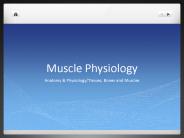Muscle Physiology - PowerPoint PPT Presentation
Title:
Muscle Physiology
Description:
Muscle Physiology Summer Prematriculation Program Summer 2004 Rahul Dave Rdave2_at_uic.edu (312) 996-7610 Rm 206 CMW Muscle Anatomy Motor Unit Skeletal Muscle Smooth ... – PowerPoint PPT presentation
Number of Views:93
Avg rating:3.0/5.0
Title: Muscle Physiology
1
Muscle Physiology
- Summer Prematriculation Program
- Summer 2004
- Rahul Dave
Rdave2_at_uic.edu (312) 996-7610 Rm 206 CMW
2
Muscles act in many organ systems
3
Muscles need a signal to contract
4
Muscle Anatomy
5
MotorUnit
Main Nerve
Nerve branch
Muscle
6
SkeletalMuscle
7
Smooth Muscle
8
Cardiac Muscle 1
9
Cardiac Muscle 2
Intercalated Disc
10
3 Fiber Types
Fuel ATP Fatigues?
Fast White Glyc High Hard
Fast Red Oxid High Medium
Slow Red Oxid Low Easy
Motor Unit Size Recruitment Order Use
Fast White Large Third Power Lift
Fast Red Medium Second Jogging
Slow Red Small First Postural mm
11
Sarcomere Structure
12
Sliding Filament Theory
13
Other Muscle Proteins
Brown Tropomyosin Yellow Troponins Blue Actin B
lack Myosin Head Bind Site
Pink Myosin
14
Smooth Muscle Structure
15
Muscle Structure
- Describe the hierarchy of organization in muscle
- Distinguish smooth, skeletal and cardiac muscle
based on histology - Understand and rationalize the differences
between fiber types - Know the skeletal muscle sarcomere structure cold.
16
Nerve-MuscleInterface
17
Excitation-Contraction Coupling
18
Cross Bridge Cycle
19
Smooth MuscleNerve-Muscle Interface
20
E-C Coupling (Smooth)
21
Crossbridge Cycle (Smooth)
22
Muscle Contraction
- Know each step in transmission across the
neuromuscular junction - Know each step in E-C Coupling for striated
muscle - Know each step in the cross-bridge cycle for
striated muscle - Know the differences between smooth and striated
(skeletal cardiac) muscle
23
Preload and Afterload
Preload The force (load) a muscle exerts prior to
contraction. Pre-contraction Afterload Force
muscle exerts during contraction. After the
start of contraction
Demonstration
24
Frank-Starling Law
25
Force-Velocity Curve
26
Exercise Physiology
- These are all adaptations
- Learning new motor patterns
- Strength exercises muscle hypertrophy
- Endurance exercises changes in muscle metabolism
27
Muscle Diseases
- Metabolism
- Lactic Acidosis
- Glycogen Storage Diseases
- Muscle Function
- Dilated Cardiomyopathy
- Muscular Dystrophy
- Malignant Hyperthermia
- Neurologic
- Hirschsprungs disease
- Myesthenia Gravis
- Multiple Sclerosis
- Parkinsons Disease
- Polio































